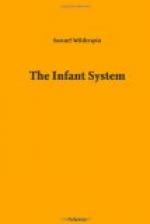As far as regards the general principles of numerical tuition, it may be sufficient to state, that we should begin with unity, and proceed very gradually, by slow and sure steps, through the simplest forms of combinations to the more comprehensive. Trace and retrace your first steps—the children can never be too thoroughly familiar with the first principles or facts of number.
We have various ways of teaching arithmetic, in use in the schools; I shall speak of them all, beginning with a description of the arithmeticon, which is of great utility.
[Illustration]
I have thought it necessary in this edition to give the original woodcut of the arithmeticon, which it will be seen contains twelve wires, with one ball on the first wire, two on the second, and so progressing up to twelve. The improvement is, that each wire should contain twelve balls, so that the whole of the multiplication table may be done by it, up to 12 times 12 are 144. The next step was having the balls painted black and white alternately, to assist the sense of seeing, it being certain that an uneducated eye cannot distinguish the combinations of colour, any more than an uneducated ear can distinguish the combinations of sounds. So far the thing succeeded with respect to the sense of seeing; but there was yet another thing to be legislated for, and that was to prevent the children’s attention being drawn off from the objects to which it was to be directed, viz. the smaller number of balls as separated from the greater. This object could only be attained by inventing a board to slide in and hide the greater number from their view, and so far we succeeded in gaining their undivided attention to the balls we thought necessary to move out. Time and experience only could shew that there was another thing wanting, and that was a tablet, as represented in the second woodcut, which had a tendency to teach the children the difference between real numbers and representative characters, therefore the necessity of brass figures, as represented on the tablet; hence the children would call figure seven No. 1, it being but one object, and each figure they would only count as one, thus making 937, which are the representative characters, only three, which is the real fact, there being only three objects. It was therefore found necessary to teach the children that the figure seven would represent 7 ones, 7 tens, 7 hundreds, 7 thousands, or 7 millions, according to where it might be placed in connection with the other figures; and as this has already been described, I feel it unnecessary to enlarge upon the subject.
[Illustration]
THE ARITHMETICON.
It will be seen that on the twelve parallel wires there are 144 balls, alternately black and white. By these the elements of arithmetic may be taught as follows:—




